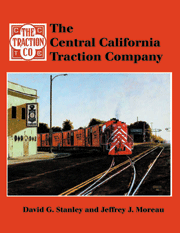The Central California Traction Company
by David G. Stanley and Jeffrey J. Moreau

Central California Traction had its origins in 1902 as a streetcar service in Stockton, California. Conceived by Howard H. Griffiths as an improved system to compete against Stockton's venerable narrow-gauge line, the Stockton Electric Railroad, Griffiths' vision became reality in 1905 with the incorporation of the Central California Traction Company. Modern, standard-gauge electric cars began serving the San Joaquin Valley's inland port city, offering connections to the steam trains of the Southern Pacific, the young Atchison, Topeka & Santa Fe, and the forthcoming Western Pacific lines. As fate would have it, these three companies would become controlling owners of the CCT in January 1928.
Electric interurban passenger service to nearby Lodi began in 1907 as ownership of the CCT was passed on from Griffiths to wealthy entrepreneurs Herbert and Mortimer Fleishhacker of San Francisco. Further expansion to Sacramento was completed in 1910, with both passenger and freight services offered over the 53-mile line. Soon, 48 daily passenger trains were listed in the timetable, all propelled by a 1,200-volt dc third-rail power distribution system, the first installation of its kind in the United States.
Although the Stockton streetcar service was a financial failure, a similar service operated by CCT in Sacramento proved successful and ran from 1910 until 1946. Interurban passenger service ended in 1933, even as freight business grew substantially. Modernizing the line in 1946, diesel locomotives replaced the "juice jacks." Now 101 years after its groundbreaking, the CCT continues to operate as an important freight carrier, and retains its corporate identity.
The complex story of this road's history has been thoroughly researched through the last decade by noted historian Jeff Moreau and by photographer/historian Dave Stanley. They collected a superb set of historic photographs and other materials, and John Signor prepared maps for the book. Stanley also used extensive interviews with employees as well as recollections from his own years as a CCT trainman to complete the story. John Signor created the painting shown on the jacket, depicting a CCT train in street running in Lodi
The 626 photographs, along with 23 maps, numerous ephemera and graphics, equipment drawings and rosters, and numerous sidebars richly document the story. The company's interaction with its parent railroads as well as with the Sacramento Northern, Stockton Terminal & Eastern, and Tidewater Southern Railways will be of interest to both historians and fans of not only electric railroads but California railroading in general.
Also available: Full reviews of this book as well as the Table of Contents of the book.
Particulars: Central California Tractionby David G. Stanley and Jeffrey J. Moreau
List price: $65 Size: 410 pages, 8.5" x 11"; 626 photos (54 in color); 23 maps and drawings, equipment roster, bibliography, index
ISBN: 1-930013-06-X Publication date: September 15, 2002
Distribution: Western Star Distributors, Lompoc, CA; or direct from publisher.